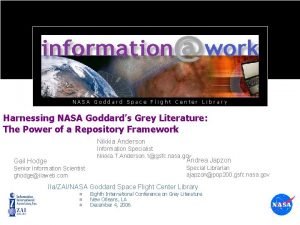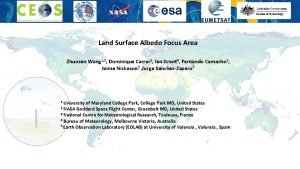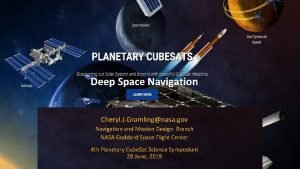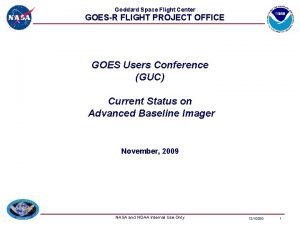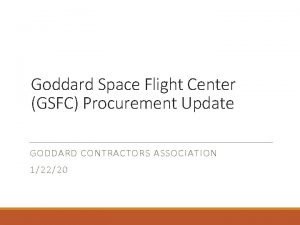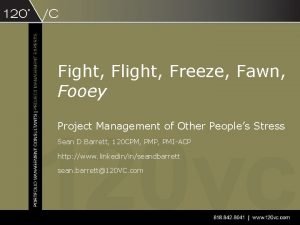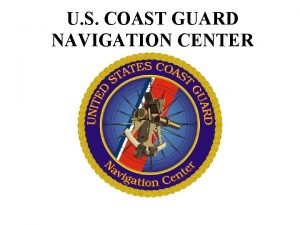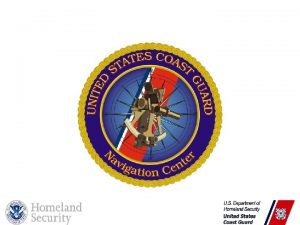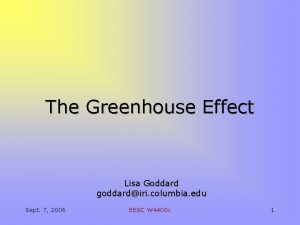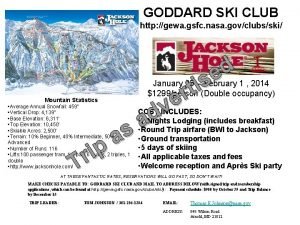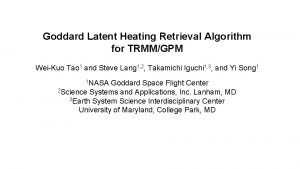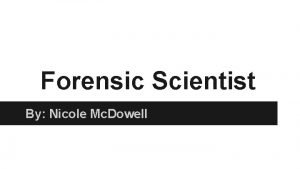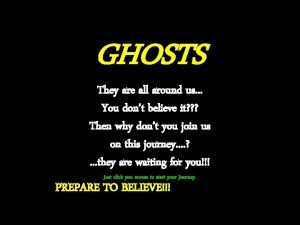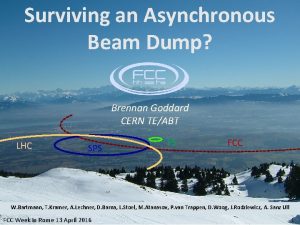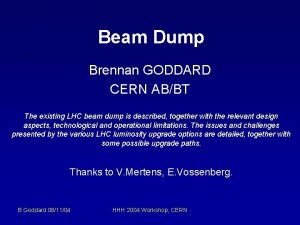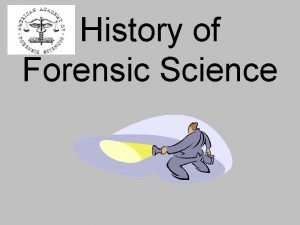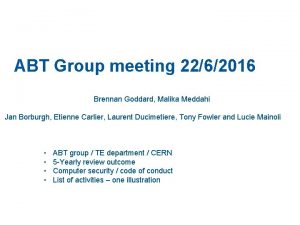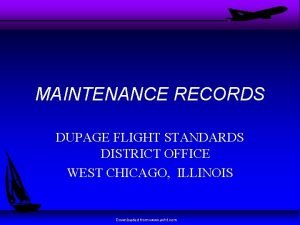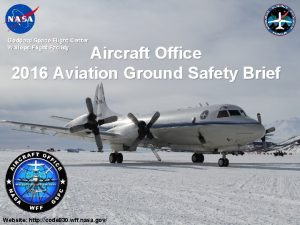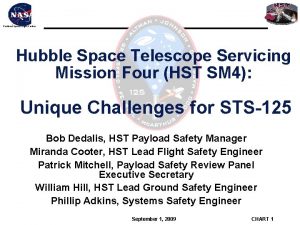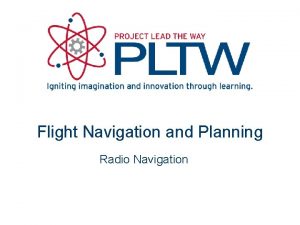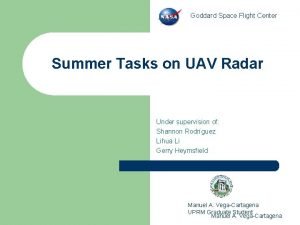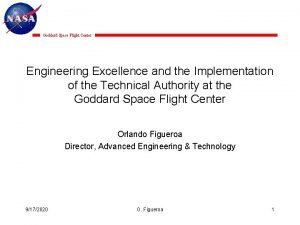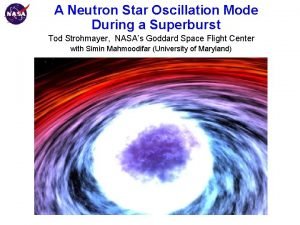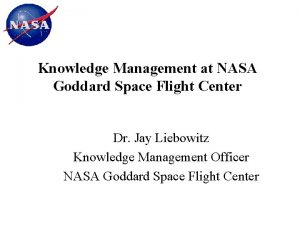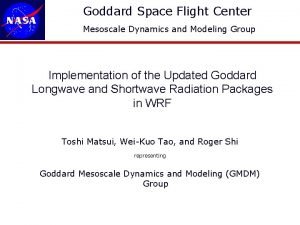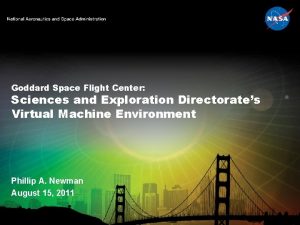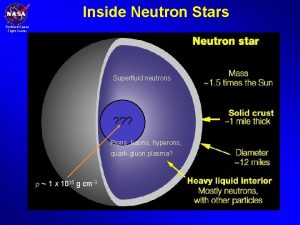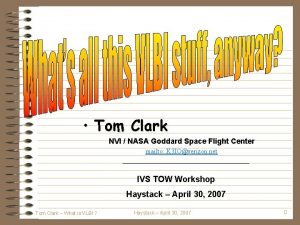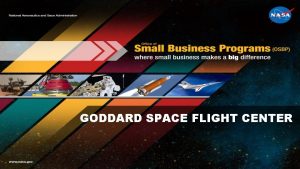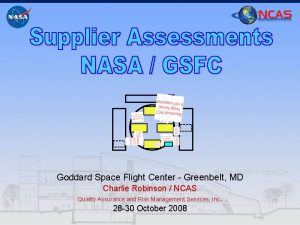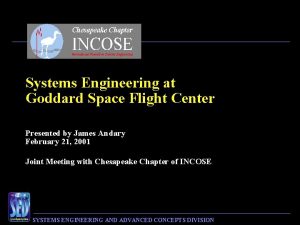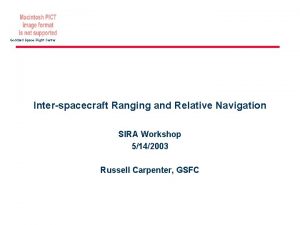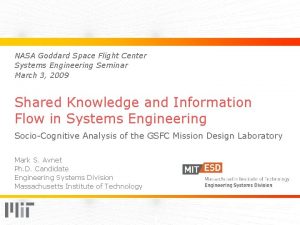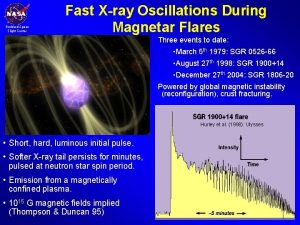Goddard Space Flight Center Deep Space Navigation Cheryl





















- Slides: 21

Goddard Space Flight Center Deep Space Navigation Cheryl. J. Gramling@nasa. gov Navigation and Mission Design Branch NASA Goddard Space Flight Center 4 th Planetary Cube. Sat Science Symposium 28 June, 2019

Goddard Space Flight Center Agenda • Navigation Regimes • Data Types and Systems • Capabilities and SWa. P 4 th Planetary Cube. Sat Science Symposium, NASA GSFC, June 27 -28, 2019 3 rd Planetary Cube. Sat Science Symposium, NASA GSFC, August 16 -18, 2018 2

Goddard Space Flight Center Defining Navigation Regimes • Near Earth – central body is Earth or within 2 e 6 km of earth • Planetary – Moon, Planets and their moons, Asteroid, • Heliocentric – Non-Planetary designs, Drift away • Navigation refers to: • Knowledge of the mission orbit wrt the central body (absolute) or wrt another object (relative) • Knowledge of where the object resided or currently resides in the orbit (definitive) or will reside in the future (predictive), • The trajectory design associated with achieving the mission, • How to modify the object’s orbit to follow that trajectory, • And the time associated with each of these. 4 th Planetary Cube. Sat Science Symposium, NASA GSFC, June 27 -28, 2019 3

Goddard Space Flight Center Navigation Regimes Near Earth DSN Planetary GEO TDRSS Possible ~15+ RE Libration, L 1 GPS ~7 RE ~4 RE LEO MMS Phase 2 25 RE . . . GPS Weak-signal Possible L 1 ~50 RE L 2 ~70 RE Potential Lunar Nav 4 th Planetary Cube. Sat Science Symposium, NASA GSFC, June 27 -28, 2019 4

Goddard Space Flight Center Forms of Direct Measurements • Time Delay • Differential Delay • Frequency shift (Doppler) or Carrier Phase • Frequency Change Rate • Angular Change, Orientation Range (Distance) Angle Line of Sight Velocity Line of Sight Acceleration Bearing, Range One common element among each of these is: TIME 4 th Planetary Cube. Sat Science Symposium, NASA GSFC, June 27 -28, 2019 5

Goddard Space Flight Center Time is Fundamental Flight Units TCXO OCXO Cs Rb Space Qualified: 1 sec/31, 688 years 4 th Planetary Cube. Sat Science Symposium, NASA GSFC, June 27 -28, 2019 6

Goddard Space Flight Center TIME is the Facilitator § Ground element timing establishes boundary condition for end-user performance § Applicable to communications, radiometrics, and science § Sources clock and frequency • • • Delay accountability Phase noise & jitter Coherency • Automatic exchange of timing state during a communication session enables: • Synchronization across long distances • Time-based communication schemes • Universal and onboard timing sources needed as orbit moves away from Earth • Round trip light time (RTLT) challenges our ability to perform navigation operations in real time ØOvercome by moving navigation onboard the spacecraft to provide in-situ realtime operations 4 th Planetary Cube. Sat Science Symposium, NASA GSFC, June 27 -28, 2019 7

Goddard Space Flight Center Data Types & Systems Measurement Type Providing Systems Range – tone, swept tone GN, TDRS TTC, DSN Range – PN TDRSS, GPS, DSN (variation) Doppler or Carrier Phase All Angles – Direct Observation GN, TDRS Celestial Navigation – Indirect Angles Star Sensor/Camera, Earth/Sun Sensors Delta Differenced One-Way Range - Angles DSN with Quasars Imaging/Optical Navigation Camera XNAV X-Ray Pulsars Detector Perturbations – non-grav Accelerometer Time Oscillator, Time Distribution Range & Doppler can be either 1 -way or 2 -way; Both improved by differencing. 4 th Planetary Cube. Sat Science Symposium, NASA GSFC, June 27 -28, 2019 8

Goddard Space Flight Center Planetary Navigation • Planetary Navigation options include traditional ground based, or can be facilitated by onboard systems Traditional ground-based option includes Onboard options include • Use of the NEN and/or DSN • DSN compatible transponder, e. g. IRIS-V 2, or DST • Doppler or pseudorange measured onboard from received communication signal using the receiver • Requiring multiple station contacts • Optical Navigation using a camera • Higher precision or faster plane-of-sky knowledge requires two ground stations simultaneously for DDOR • Accelerometer/IMU • X-ray Pulsar Detector • All use Flight Software – Delta T = R/C Delt af • • • unifies the system, runs under c. FS Processes measurements Provides onboard knowledge of orbit and attitude Plans maneuvers Executes & controls maneuvers through closed-loop feedback • Improved accuracy and convergence using onboard system, especially for frequent maneuvers formation control, momentum uploads, near-body targeting 4 th Planetary Cube. Sat Science Symposium, NASA GSFC, June 27 -28, 2019 9

Goddard Space Flight Center Optical Comm: Optimetrics at the Moon Gateway (NRHO) MC Max RSS position error: 1. 5 m apolune, 17. 6 m perilune • 1 -way forward laser signal to vehicle from Earth stations. • Observations taken and processed onboard in real time. • Can be complemented with other data types (GPS, TRN) Lander During Descent (with maneuvers) RSS position error: 1 -5 m, 157 m @ touchdown 4 th Planetary Cube. Sat Science Symposium, NASA GSFC, June 27 -28, 2019 10

Goddard Space Flight Center Optical Navigation, 1 Optical Navigation (Op. Nav) is a technique by which digital images can be used to determine the relative position and orientation of a camera with respect to something observed in the image There are 3 primary types of Op. Nav: star-based, celestial, and relative. Star based Op. Nav generates inertial pointing measurements Cel. Nav produces bearing measurements to a number of objects Relative Op. Nav (Rel. Nav) generates bearing/position estimates to an observed object Venus Mars Jupiter Star based Cel. Nav 4 th Planetary Cube. Sat Science Symposium, NASA GSFC, June 27 -28, 2019 Rel. Nav

Goddard Space Flight Center Optical Navigation, 2 The type of Cel. Nav/Rel. Nav used depends on the apparent size of the body in the image. X Star based Cel. Nav Rel. Nav Unresolved Body Model Fitting Extended Body Center Finding Surface Feature Navigation (SFN) Terrain Relative Navigation (TRN) LROC image, April 2019 4 th Planetary Cube. Sat Science Symposium, NASA GSFC, June 27 -28, 2019

Goddard Space Flight Center Pulsar Navigation – X-Nav • Couples precision timing of distant pulsars with geometric diversity to determine orbital state and time • Provides plane of sky information • Universally available • Advancements expected to achieve Cube. Sat SWa. P

Goddard Space Flight Center Autonomous Navigation, Guidance, Control • Onboard navigation operational since 1999 in LEO, 2015 in HEO (formation) • Follow-on to onboard orbit estimation is onboard orbit control: autonomous maneuver planning, execution, and calibration • Auto. Control demonstrated on EO-1 in 2000; Established for single mission • Reduces ground ops required for maneuver planning and execution and associated risks • Requires telemetry feed from the maneuver, similar to ground planning/execution/calibration process • Algorithms for maneuver planning and formation missions being implemented in FSW via IRAD 4 th Planetary Cube. Sat Science Symposium, NASA GSFC, June 27 -28, 2019 14

Goddard Space Flight Center Simplified Measurement Capability • Broad summary of measurement capability • Not intended to indicate one size fits all • Some measurements not available in real-time • Snowflake-like possible combinations for performance & robustness Orbit GPS NEN/DSN (ground, radio) 10− 20 m @ 50 cm @ 1 Hz 1. 5 orbit LEO HEO (perigee < constellation) 10 m @ 1 Hz GEO Lunar, in view (onboard, laser) ΔDOR (DSN) Op. Nav: CELNAV N/A 5 m @ 1 Hz 100 m 1 e-3 m 100− 200 m @ 36 hrs 1 e-3 m 15 -26 m 50 -200 m @ 2 days 1. 5 m 0. 5 km @ 0. 5 1 km @ 1 days N/A 4 -32 km @ 3 wks 1. 5 m 8 -15 km @ 3 wks -- -- 0. 5 km @ 0. 5 N/A days 5− 15 km @ 3 1 km @ 1 days 5 -10 km @ 3 1 km @ 1 days Sun-Earth L 1/L 2 N/A N/A Op. Nav: TRN -- -1 km @ 2 hr 0. 1− 15 km @ 1 -- -orbit 1− 5 km @ 1 -- -orbit 1 e-3 m Lunar, far side/hi lat N/A Planetary NEN/DSN Requirement/ Source ≤ few m < 1 km / many 10 m / many 0. 3 m (w NEN laser) 500 m / LRO 5 -12 m (w maneuvers) 500 m / LRO -- -- 8 km / WFIRST 1 -5 m ~ 5 km / Lucy 4 th Planetary Cube. Sat Science Symposium, NASA GSFC, June 27 -28, 2019 15

Goddard Space Flight Center Estimated SWa. P-C Unit Description Size Mass (kg) Power (W) Cost ($K/FTE) Notes RAFS Supplies uniform, common stable time and frequency reference source with synchronized distribution across all elements; synchronizes to the earth ground element reference source; acts as Master Reference onboard the GW/Lander for all subsystems and units (see notes) 4 e-4 m 3 2. 5 Liters 0. 45 - 3. 4 10 -35 600/0. 3 2 x 2 x 2 cm 0. 2 1 20 Miniature Integrated Star Tracker (camera) Provides angular measurements to define planeof-sky using distant sources (stars, planets), imaging of target celestial body limbs for Optical Navigation, and imaging of target (celestial object or a vehicle) surface features for Terrain Relative Navigation 0. 75 U 0. 7 <4 500/. 4 Radiation hardened; 3 heads; main unit needed for attitude quaternion; 33% of listed SWa. P-C applies to nav, 67% on bus Nav. Cube 3. 0 Weak-Signal GPS Receiver Observability of GNSS signals, including sidelobes, for pseudorange -- useful in cis-lunar or lunar vicinity 20. 5 x 28 x 1 4 cm 6 20 -25 1300/1. 5 Power depends on whether Discrete RF card of ASIC RF card is used; can be included as part of small satellite architecture L-Band Antenna Patch-type antenna for GPS TBD TBD Accelerometer to resolve maneuver DV 24. 6 x 25. 5 x 3 8 cm/u 0. 071 x 3= 0. 213 0. 48 x 3 = 1. 44 10 x 3= 30 e. g. Honeywell QA 3000, x 3 units GEONS Heritage flight software that runs under core flight system to provide autonomous navigation using a fusion of data NA NA NA 350/1 Runs on C&DH processor; bus accommodates command telemetry; tailoring USO • 1. 2. 3. 4. 5. (U=10 x 10 cm) Assumptions Every element not applicable to all orbit regimes Comm Receiver outputs pseudorange and Doppler (established techniques exist for both; soft/firmware); not included in table Camera has integrated electronics with a head for far-field (attitude estimation) & at least one head for near-field imaging for Op. Nav/TRN; C&DH exists on bus capable of running GEONS/Auto. NGC SWa. P-C are per unit 4 th Planetary Cube. Sat Science Symposium, NASA GSFC, June 27 -28, 2019 Either a RAFS or a USO needed, not both. 16

Goddard Space Flight Center Planetary Navigation Summary • Navigation in the near-earth regime, 2 e 6 km, can be performed by an array of systems to provide robust solutions with seamless transitions between orbit regimes • Navigation in the planetary regime has fewer options available, with traditional ground support using radiometric (or optimetric) tracking and onboard systems that rely on sensors and/or comm systems • Flight components are developed to meet the Cube. Sate size, weight, and power constraints • Components within a communications system influence the resultant radio/optimetric tracking data quality • GSFC Navigation offers relevant pre- and post-launch services to the planetary user and networks communities • Navigation needs to be an enabler for the science NASA hopes to achieve in the future – technology investments are key. 4 th Planetary Cube. Sat Science Symposium, NASA GSFC, June 27 -28, 2019 17

Goddard Space Flight Center BACKUP 4 th Planetary Cube. Sat Science Symposium, NASA GSFC, June 27 -28, 2019 18

Goddard Space Flight Center Simplified Navigation: Science Categories • Broad summary of navigation categories • Not intended to indicate one size fits all • More snowflakes • Mission unique elements • Combination of many known components Category Absolute Definitive Lower Accuracy 100 – 300 m Accurate 5 – 40 m High Accuracy 50 cm – 10 m Precision Navigation < 1 mm – 50 cm Absolute Predictive (1 day) 1 km 75 – 500 m 5 – 50 m 5 cm – 5 m Relative Definitive 1 – 50 m 1 – 10 m 0. 1 – 1 m <0. 1 mm – 1 m Relative Predictive (1 day) <0. 5 km 50 – 75 m 1 – 10 m 0. 1 mm – 10 cm Science Objective Astro, Spatial, Loose temporal Temporal, Surface Observer, Human Temporal, Surface Observer/Altimetry, Human Altimetry, Gravity, Interior Composition Orbit Regime Low, GEO, High, Low, libration, helio cruise, loose formation, approach, formation, precise cis-lunar cruise cluster maneuvers low, GEO, High, precise formation, rendezvous/docking 4 th Planetary Cube. Sat Science Symposium, NASA GSFC, June 27 -28, 2019 19

Sensors Goddard Space Flight Center • GPS/GNSS Receiver • GSFC developed weak-signal GPS; licensed to companies (BRE) • Assists in coverage in higher altitudes ou tto lunar distances • Crosslink • Developed as element integrated with weak-signal GPS receiver to TRL 5 for MMS • 1 -way range & Doppler measurement for relative navigation • Low-rate data on signal (exchange science alerts, Health & Safety, nav) • Autonomous Rendezvous and Docking Sensor • XNav sensor (pulsar detector); translates pulsar timing to pseudo-range observation • Star Camera • Accelerometer • Integrate navigation sensor with communications receiver 4 th Planetary Cube. Sat Science Symposium, NASA GSFC, June 27 -28, 2019 20

Goddard Space Flight Center Systems • Fusion of multiple data types from independent systems • Robust to outages or shortcomings of any one system • High accuracy • Seamless transitions across orbit regimes • GEONS flight software processes forward Doppler from ground stations and TDRSS, attitude sensor data for celestial nav, GPS, crosslink & broadcast service pseudo-range, Xnav, Op. Nav/TRN • Solves for absolute and relative navigation • Works under core Flight System • Test Facility: Formation Flying Test Bed • Provides Test As You Fly simulation capability • GPS simulator, Path Emulator for RF Signals, User Dynamics Environment Simulator • From the spacecraft side, as comm subsystem is developed, nav and comm engineers need to work together to define requirements 4 th Planetary Cube. Sat Science Symposium, NASA GSFC, June 27 -28, 2019 21
 Goddard space flight center library
Goddard space flight center library Albedo
Albedo Cheryl gramling
Cheryl gramling Cheryl goddard
Cheryl goddard Gsfc contractors
Gsfc contractors Fight flight freese
Fight flight freese Deep asleep deep asleep it lies
Deep asleep deep asleep it lies Deep forest towards an alternative to deep neural networks
Deep forest towards an alternative to deep neural networks O the deep deep love of jesus
O the deep deep love of jesus Us coast guard navigation center
Us coast guard navigation center Us coast guard navigation center
Us coast guard navigation center Lisa goddard columbia
Lisa goddard columbia Nasa ski club
Nasa ski club Goddard heating and air
Goddard heating and air Father of bloodstain identification
Father of bloodstain identification Fiona goddard
Fiona goddard Look around you ghosts
Look around you ghosts Brennan goddard
Brennan goddard Brennan goddard cern
Brennan goddard cern Calvin goddard contribution to forensic science
Calvin goddard contribution to forensic science Malika meddahi cern
Malika meddahi cern Dupage flight center aircraft maintenance
Dupage flight center aircraft maintenance
